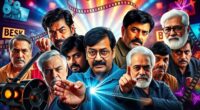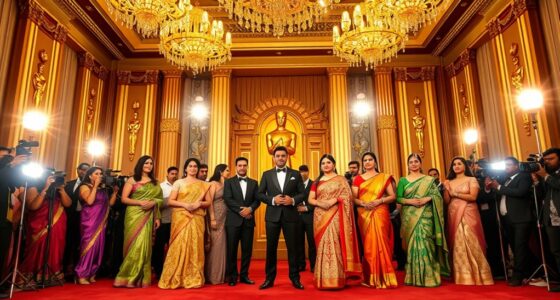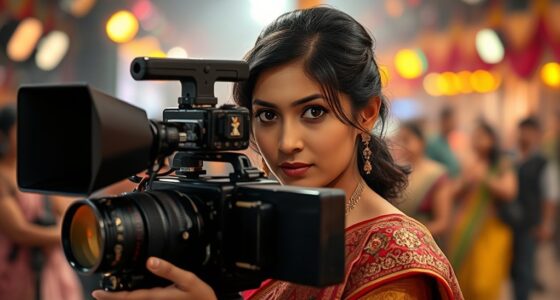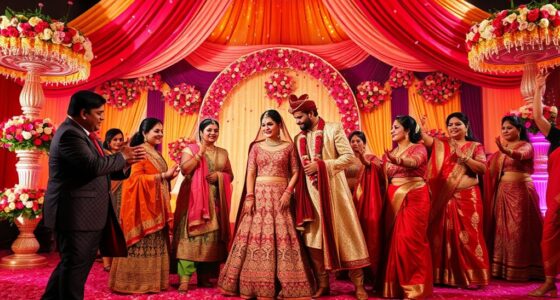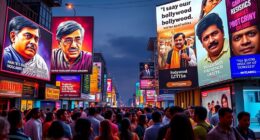If you’re a Bollywood fan enthusiastic to explore underrated gems, these ten cult classics are a must-see. Films like *Aankhen* blend Hollywood-style heist with Bollywood flair, while *Raincoat* offers poetic minimalism about love and vulnerability. *Manorama* revives noir with atmosphere and grit, and *Lagaan* combines history, sports, and patriotism. From social scandals in *Khosla Ka Ghosla* to the emotional depth of *Black Friday*, you’ll find bold storytelling at every turn. Keep going to uncover more surprises.
Key Takeaways
- Films like *Aankhen* and *Raincoat* blend genre influences with unique storytelling, earning cult status despite limited mainstream recognition.
- Visually and emotionally innovative films such as *Manorama* and *Black Friday* offer fresh perspectives on Indian noir and realism.
- Underrated classics often feature symbolic storytelling and cultural depth, resonating deeply with niche audiences and cinephiles.
- Movies like *Lagaan* and *Filmistaan* showcase cultural themes and social commentary, elevating their status among dedicated fans.
- These films demonstrate how creative narratives and stylistic experimentation cultivate lasting cult appeal beyond commercial success.
Aankhen (2002)

Have you ever wondered what happens when Hollywood-style heist concepts meet Bollywood’s traditional storytelling? That’s exactly what you get with Aankhen (2002). You follow Vijay Singh Rajput, a fiery bank manager seeking revenge after losing his job. Instead of a typical plan, he recruits three blind men—Vishwas, Arjun, and Ilias—to pull off a daring bank robbery. The film combines intense crime thriller elements with Bollywood’s signature songs and emotional depth. Amitabh Bachchan’s powerful performance drives the story, while Akshay Kumar, Arjun Rampal, and Paresh Rawal bring the heist to life. Despite mixed reviews for its plot holes, Aankhen’s unique concept, blending Hollywood-style heist tactics with Bollywood flair, has made it a cult classic that continues to captivate audiences today. Additionally, understanding intellectual property rights can help filmmakers and creators protect their work in a competitive industry. Incorporating cultural elements can also enhance the film’s appeal across diverse audiences. Moreover, the film’s innovative storytelling approach has inspired many subsequent Bollywood movies to experiment beyond conventional formulas. Exploring visual storytelling techniques can further elevate the narrative and engage viewers more deeply.
Raincoat (2004)

Raincoat masterfully captures deep emotions through its understated storytelling, making you feel the characters’ loneliness and longing. The film’s romantic melancholy lingers long after watching, emphasizing the pain of unrealized love. Its minimalist approach keeps the focus on subtle performances and the quiet power of simple moments.
Emotional Depth
The film’s emotional depth is vividly conveyed through its exploration of characters’ inner struggles and complex relationships. You’ll see how social status and false appearances mask harsh realities, revealing the characters’ vulnerabilities. Neerja’s paranoia and disillusionment expose her deep fears and sense of isolation, while Manoj’s resilience highlights his emotional resilience amid financial struggles. The film uses nostalgia and emotional connections to evoke longing for the past, emphasizing themes of love, loss, and regret. Raincoat’s rainy setting intensifies the somber mood, reflecting the characters’ inner turmoil. Supporting characters add layers of truth and conflict, deepening the story’s emotional impact. Ultimately, the film’s portrayal of human vulnerability invites you to reflect on how circumstances shape identity and emotional resilience. The setting’s weather also plays a symbolic role, mirroring the characters’ emotional states and adding to the film’s poignant atmosphere. Exploring emotional expression in cinema can deepen your understanding of human resilience and vulnerability, making Raincoat a compelling example of emotional storytelling. Additionally, the use of visual symbolism enhances the film’s emotional storytelling by visually emphasizing the characters’ inner worlds. Recognizing the importance of payment data security can help viewers appreciate how safeguarding personal information parallels the emotional safeguarding depicted in the film.
Romantic Melancholy
What makes *Raincoat* resonate with viewers is its profound sense of romantic melancholy, capturing the bittersweet pain of unfulfilled love. You feel the ache as Manoj and Neerja reconnect, revealing the ache of past feelings left unresolved. The film explores societal expectations that push Neerja into marriage, contrasting her outward appearance of contentment with her inner struggle. Manoj’s financial struggles and shame add to the film’s somber tone, emphasizing the emotional weight of their separate lives. The monsoon rains heighten this mood, creating a reflective atmosphere. The raincoat itself becomes a symbol of their fragile connection, as notes exchanged beneath it expose hidden truths. *Raincoat* beautifully depicts love’s complexity, blending longing with resignation, leaving a lasting impression of romantic melancholy. Additionally, the cinematography and soundtrack enhance the emotional depth, making it a poignant example of romantic storytelling and its power to evoke emotional resonance. Recognizing the film’s emotional impact deepens appreciation for its nuanced portrayal of love’s bittersweet nature. Exploring the symbolism in rain reveals how natural elements heighten the film’s introspective tone, highlighting the importance of dream symbols in expressing subconscious emotions.
Minimalist Storytelling
| Theme | Representation |
|---|---|
| Societal Expectations | Subtly explored through dialogue, highlighting the constraints faced by individuals. |
| Hidden Emotions | Revealed through gestures and silence, emphasizing the power of non-verbal communication. |
| Symbolism | Raincoat as a symbol of truth, representing vulnerability and honesty in relationships. |
| Subtext and Nuance | Demonstrates emotional intelligence in storytelling, showing the depth of characters’ feelings. |
Manorama: Six Feet Under (2007)
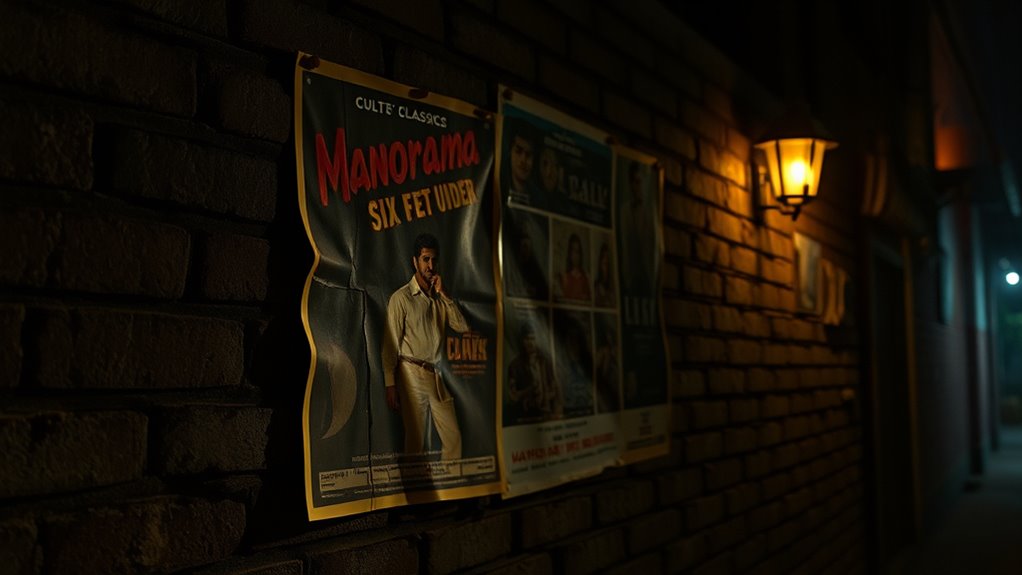
Ever wondered how Indian cinema can master the neo-noir genre with a film like Manorama: Six Feet Under? This 2007 gem, directed by Navdeep Singh, immerses you in Rajasthan’s dusty landscapes, creating a stark, atmospheric backdrop. You follow Satyaveer, a disillusioned engineer turned amateur detective, as he probes a politician’s alleged affair, only to stumble into a web of lies, corruption, and murder. The film’s sharp dialogues, layered with dark humor, enhance its suspense. Sarika’s portrayal of the enigmatic Manorama adds depth, while Kulbhushan Kharbanda’s minister exudes menace. Visually striking, with noir-inspired lighting and haunting music, it revitalizes Indian noir, blending mystery with gritty realism. Despite modest box office success, it’s a cult classic for cinephiles seeking a gripping, atmospheric thriller. An understanding of film genres can deepen viewers’ appreciation of its stylistic choices and narrative techniques. Additionally, the film’s visual style, characterized by high-contrast lighting and moody shadows, further immerses the audience in its noir-inspired aesthetic. Furthermore, the careful selection of ingredients such as lighting and music plays a crucial role in establishing the film’s tone and mood, echoing techniques used in personal development tools like visualization and mindfulness to craft a compelling atmosphere. Recognizing the use of figurative language, such as metaphors and symbolism, can also enrich the viewer’s engagement with the film’s deeper themes.
Black Friday (2004)
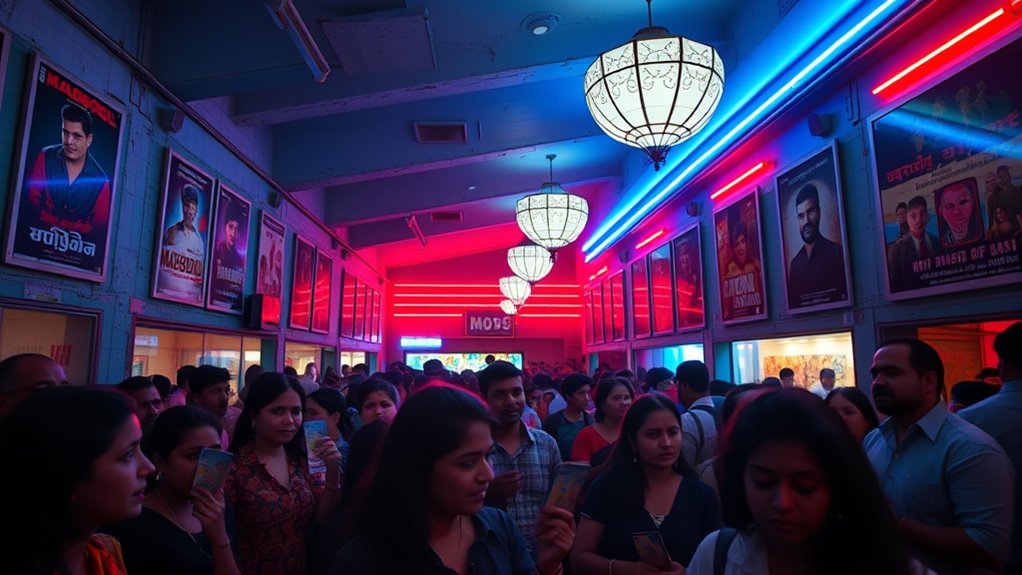
Black Friday (2004), directed by Anurag Kashyap, stands out as a gritty and unflinching portrayal of the 1993 Bombay bombings, based on Hussain Zaidi’s detailed book. You’ll see a raw, realistic depiction of the chaos, investigation, and aftermath through multiple perspectives—police officers, conspirators, and ordinary citizens. The film highlights the relentless efforts of investigators like Rakesh Maria and the involvement of underworld figures such as Tiger Memon and Dawood Ibrahim. Its non-linear storytelling, with flashbacks and overlapping viewpoints, feels like a sprawling documentary, immersing you in intense interrogation scenes and communal tensions. Kashyap’s direction avoids sensationalism, focusing instead on the political and social complexities behind the tragedy, making it a powerful, underrated crime drama.
Monsoon Wedding (2001)
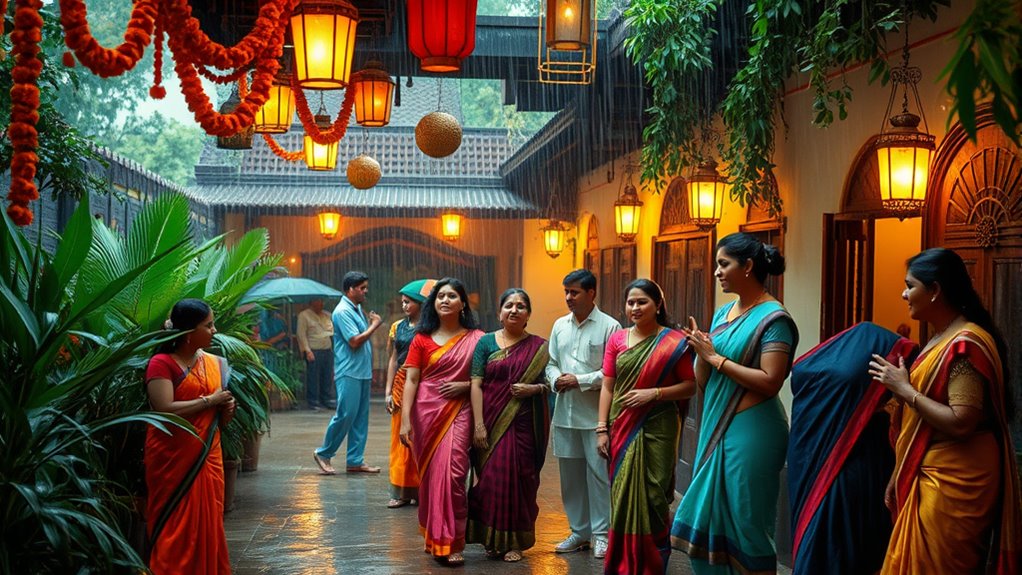
While Black Friday exposes the dark underbelly of Mumbai’s criminal world, Mira Nair’s Monsoon Wedding offers a vibrant look at modern Indian family life. You see a bustling Punjabi family preparing for a wedding in Delhi, blending comedy, drama, and romance. As chaos unfolds, you witness themes of tradition versus modernity, love, infidelity, and family loyalty. The film’s authentic portrayal captures India’s linguistic diversity and societal tensions, making it relatable worldwide. It’s celebrated for its colorful cinematography and honest storytelling that balances serious issues with humor. This film’s impact extends beyond entertainment, highlighting contemporary Indian middle-class struggles and values with warmth and authenticity. Its cultural authenticity and depiction of societal change have helped it resonate with audiences globally. Additionally, its portrayal of modern Indian society underscores the ongoing shifts within India’s social fabric, adding depth to its cultural significance. The film’s nuanced depiction of social change reflects India’s rapid development and evolving cultural landscape. Moreover, the film subtly explores the production quantity variance within the context of changing societal expectations, symbolizing the shifting dynamics of traditional and modern values.
Ankhon Dekhi (2013)

“Ankhon Dekhi” stands out with its unique storytelling approach that challenges conventional narrative techniques. Sanjay Mishra delivers a remarkable performance, bringing depth and authenticity to Bauji’s philosophical journey. The film explores profound themes like empiricism and societal norms, making it a thought-provoking watch you won’t forget. Additionally, its use of essential oils as a metaphor for clarity and perception adds a subtle layer of meaning to the narrative. The film’s support hours and availability can enhance your viewing experience by allowing you to plan accordingly and access the film through various platforms.
Unique Narrative Style
Ankhon Dekhi stands out for its innovative storytelling that seamlessly blends philosophy and humor, enthralling viewers with a fresh narrative approach. You’ll notice how the film explores empiricism, with the protagonist only trusting what he can see, creating a compelling lens on perception and belief. Its realistic depiction of life in a Delhi neighborhood grounds the story, making philosophical themes like trust, love, and societal norms feel relatable. The narrative is sparked by a random incident that shifts Bauji’s worldview, leading to unexpected character developments and social commentary. The ensemble cast enriches this layered tale, emphasizing community dynamics and individual choices. This unique style challenges conventional storytelling, making “Ankhon Dekhi” a standout cult classic that encourages you to question your perceptions.
Sanjay Mishra’s Performance
Sanjay Mishra delivers a nuanced and compelling performance as Bauji, anchoring the film’s philosophical and emotional core. His portrayal captures Bauji’s quiet wisdom, subtle humor, and inner turmoil with authenticity. Mishra’s restrained delivery highlights the character’s introspection, making Bauji’s worldview believable and relatable. Critics praised his performance as a standout, showcasing his versatility beyond comedic roles. This role marked a significant milestone in Mishra’s career, demonstrating his ability to carry a film with depth. His chemistry with Seema Pahwa and the supporting cast enhances the emotional resonance of the story. Mishra’s understated yet powerful acting contributed greatly to the film’s critical acclaim and cultural impact, solidifying his reputation as a talented actor capable of nuanced performances.
Philosophical Themes Explored
Building on the film’s emotionally charged portrayal of Bauji’s internal struggles, it also explores profound philosophical themes that challenge you to reconsider your perceptions of reality. You’ll see how the film emphasizes empiricism, focusing on believing only what you can see or experience firsthand, echoing skepticism. It questions what’s real by examining how perception shapes truth, using Bauji’s journey as a lens. Additionally, it incorporates Cārvāka philosophy, prioritizing direct sensory experience over hearsay or metaphysics. The film also explores absurdism, employing bizarre situations to highlight skepticism and societal critique. Finally, it investigates into introspection and personal truth, showing Bauji’s quest for meaning amid relationships and societal expectations.
Titli (2015)
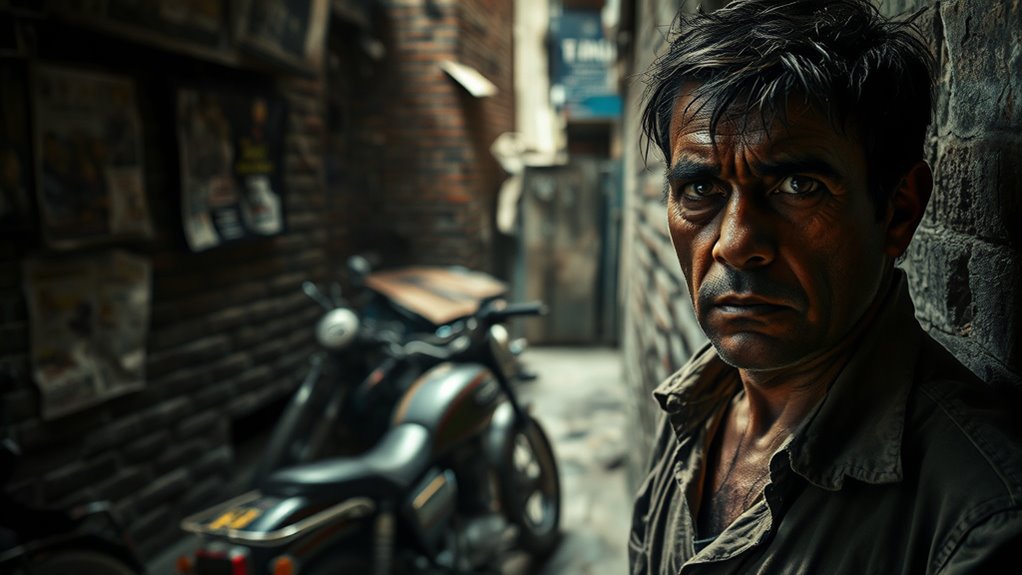
Titli (2015) offers a gritty, unflinching look into the lives of marginalized youth caught in a cycle of violence and poverty on the outskirts of Delhi. You see Titli, the youngest brother in a violent car-jacking gang, dreaming of escaping his criminal world by buying an under-construction mall. His plan falls apart when stolen money is lost, forcing him into a marriage designed to trap victims more easily. The film explores a harsh social environment where violence and shattered dreams coexist, reflecting systemic injustice and rapid urbanization. You witness how family dynamics, emotional scars, and societal neglect trap these characters, highlighting the brutal reality faced by many marginalized communities. It’s a raw, compelling portrayal of survival amidst chaos and despair.
Filmistaan (2014)

Filmistaan (2014) is a charming yet poignant film that explores the deep cultural bonds between India and Pakistan through the lens of Bollywood cinema. You follow Sunny, a Bollywood enthusiast and aspiring actor, who is mistakenly kidnapped near the India-Pakistan border. While held captive, he befriends Aftaab, a local who sells pirated Bollywood movies, highlighting shared passions across borders. The film balances humor, emotion, and political commentary without being preachy.
- Shows how Bollywood acts as a cultural bridge between nations
- Challenges stereotypes by humanizing characters on both sides
- Features iconic dialogues and references that resonate universally
- Uses humor and sincerity to address complex India-Pakistan relations
Filmistaan’s storytelling emphasizes unity through shared love for cinema, making it a must-watch underrated gem.
Khosla Ka Ghosla (2006)
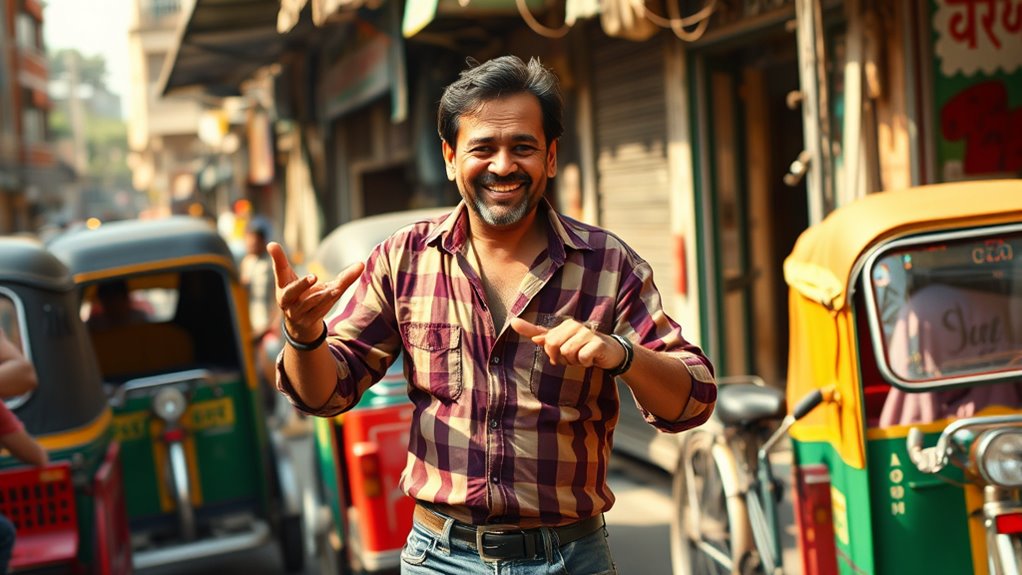
While films like Filmistaan highlight the power of cinema to bridge cultural divides, Khosla Ka Ghosla (2006) offers a sharp satirical look at the everyday struggles of urban India’s middle class. You follow Kamal Kishore Khosla, played by Anupam Kher, who fights to reclaim his land after it’s seized by a corrupt builder. Alongside his supportive wife and family, he navigates legal hurdles, police corruption, and moral dilemmas. The film humorously exposes real estate scams and middle-class vulnerabilities, all while exploring family bonds and intergenerational conflicts. Praised for its strong characters and witty storytelling, it’s become an underrated classic. Dibakar Banerjee’s direction captures the social commentary with a mix of comedy and poignancy, making it a must-watch for fans of honest, relatable cinema.
Lagaan (2001)

Set in 1893 in the village of Champaner, Lagaan immerses you in a tense confrontation between oppressed Indian villagers and British colonial rulers. You witness how a devastating drought leaves villagers unable to pay their land taxes under Queen Victoria’s rule. British officer Captain Russell offers a risky wager: if villagers beat the British cricket team, their taxes are waived for three years; if they lose, they pay triple in one year.
- Bhuvan, played by Aamir Khan, leads the villagers in accepting the challenge.
- Elizabeth Russell secretly coaches the villagers on cricket.
- Gauri, Bhuvan’s love interest, supports the struggle.
- The film uses cricket as a metaphor for colonial resistance, blending song and serious themes.
Frequently Asked Questions
What Themes Make These Films Resonate With Cult Film Enthusiasts?
You’re drawn to films that challenge societal norms and explore taboo topics like mental health and caste discrimination. These movies question traditions, spotlight marginalized voices, and promote individuality. Their unique storytelling, bold visuals, and genre-blending keep you engaged. You love rewatching for hidden details and sharing with passionate communities. These films reflect youth’s desire for rebellion, social change, and authentic voices, making them resonate deeply and inspire future storytelling.
How Do These Movies Challenge Mainstream Bollywood Narratives?
This question hits the nail on the head—these movies shake Bollywood to its core. You’ll find them challenging the usual formula with nuanced stories, complex characters, and bold social themes. They refuse to conform to predictable romance or song-and-dance routines, instead offering gritty, socially conscious narratives. By doing so, they push boundaries, question norms, and invite you to see Indian cinema from a fresh, thought-provoking perspective—far beyond the typical blockbuster fare.
In What Ways Are These Films Visually or Narratively Innovative?
You’ll notice these films stand out through their visual and narrative innovations. They use vibrant colors, unique camera angles, and minimal effects to create striking visuals. Narratively, they experiment with non-linear storytelling, complex characters, and social commentary. These elements challenge traditional Bollywood norms, offering fresh perspectives and deeper themes. By blending innovative visuals with bold storytelling, they leave a lasting impact and inspire future filmmakers to push creative boundaries.
Why Did These Films Initially Receive Limited Commercial Success?
They say “timing is everything,” and that’s true for these films. You might not have noticed them initially because they lacked effective promotion, faced stiff competition, or were released at an inopportune time. Limited budgets, inexperienced crews, and cultural mismatches also played roles. Without strong marketing or relatable themes, they struggled to find their audience early on, despite their true artistic or storytelling value.
How Have Critics and Audiences Re-Evaluated These Films Over Time?
You see, critics and audiences have re-evaluated these films over time by recognizing their originality, experimentation, and deeper themes that were overlooked initially. Digital platforms, film festivals, and online communities have helped revive interest, sparking debates and discussions. As a result, these movies are now appreciated for their influence, trendsetting qualities, and artistic value, transforming perceptions and elevating their status from misunderstood to celebrated classics.
Conclusion
So, next time you’re scrolling through Bollywood hits, skip the usual blockbusters and explore into these hidden gems. Who knows? You might just stumble upon a film so underrated, it’ll make your blockbuster obsession look like a Bollywood rerun. After all, why settle for the same old masala when you can discover cinematic treasures that truly deserve the spotlight? Trust us, your playlist will thank you—your friends, maybe not so much.

